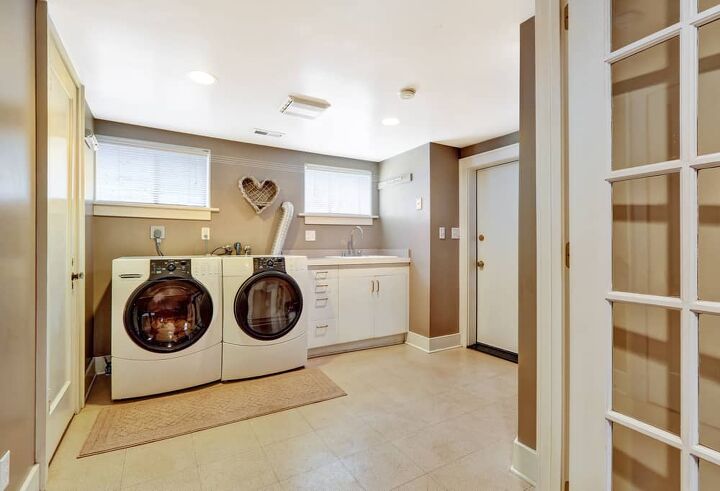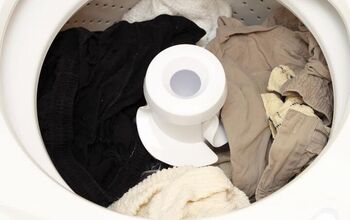Amana Washer Won't Spin? (Possible Causes & Fixes)

Owning laundry appliances is seen as a significant benefit because you don’t have to go to a laundromat where you have to share the washer and dryer with hundreds of other people. However, what a lot of people don’t realize is you’re stuck with fixing the machine if it stops working. To do so, you first have to figure out what’s wrong with it.
If your Amana washer doesn’t spin, there are several issues that could be causing the problem. These issues include the door lock, motor coupling, clutch, lid switch assembly, motor control board, transmission, drive motor, and many other possibilities.
In this guide, we will take you through each possibility. That way, you can inspect your washer and get to the bottom of everything, literally, depending on the part that needs to be replaced.
Do You Need Appliance Repair Services?
Get free, zero-commitment quotes from pro contractors near you.

Why Won’t Your Amana Washer Spin?
The spin cycle is essential for wringing out your wet clothing. So, when your washer refuses to enter the spin cycle, you’re left with a heap of sopping wet clothes that you need to hand wring yourself.
It’s essential to take a look at your washer to see what the problem is. Below, we’ve included many possible issues so that you can figure out what’s going on and get your washer back into shape.
Door Lock Is Broken
Your door lock might be broken, which will keep your washer from entering the spin cycle. To check if this is indeed the problem, you will need to look at the assembly for the door strike to check it for any signs of damage. Upon finding that it’s broken, it will need to be replaced as it’s not repairable.
Motor Coupling Failure
Your motor coupling is a part that connects the transmission to the motor inside of your Amana washer. This usually happens if you wash too large of loads because the overload will trigger the motor coupling to fail so that it protects your transmission and the motor.
Another thing that can cause the motor coupling to fail is normal wear and tear. You will need to inspect the coupling to ensure that it’s not broken. If it is, you will need to replace it before your washer works appropriately.
Worn Out Clutch
Your clutch assembly helps to connect the inner tub to the transmission and helps pace the tub at the proper speed so that it can spin without damaging the washer. However, if you have a worn-out clutch, this will keep your washer from spinning. Since the clutch is not repairable, you will need to replace it.
Failure Of The Lid Switch Assembly
You may have noticed that in the middle of a cycle, if you lift the lid, this stops your washer from spinning. This is the result of your lid switch assembly, which makes it so your washer cannot turn while the cover is open for safety reasons. Therefore, if it’s broken, your washer won’t spin.
Use a multimeter to test the continuity of the lid switch. If there is no continuity, then you will need to replace it. On the other hand, if there is, then this is clearly not the problem.
Loose Or Broken Drive Belt
Another common issue that keeps you
r washer from entering the spin cycle is a loose or broken drive belt. The drive belt is what helps spin the tub in your washer. Inspect the drive belt for any damage or to see if it’s fallen from the pulleys. If it’s loose, you can tighten it. However, if it’s broken, you’ll need to replace it.
Worn Out Drive Pulley
The drive pulley in your washer is what works with your motor and drive belt to rotate the drum. If your pulley is worn down or rusty, this will cause the drive belt to keep slipping off, which then controls the washer from entering the spin cycle.
To inspect the drive pulley, you will need to remove it. If it looks damaged or worn, then you will need a replacement. Check your model number to ensure you get the correct part.
Damaged Rotor Magnets
Your rotor magnets are what helps to rotate your tub due to the electromagnetic field that the rotor creates with the stator. If the magnets are damaged, this will keep your washer from spinning or even agitating.
If you find any damage on your rotor, then it’s safe to assume that the magnets are not working as they should. Replace the rotor to fix the problem.
Damaged Stator Assembly
If you checked the rotor and it looks fine, then you will need to check the stator assembly as well, since this is what works with the rotor to create the electromagnetic field. Look at the windings to see if they are damaged, as this will keep your washer from spinning or agitating.
Defective Motor Control Board
One of the most critical components of your washer is the motor control board, as this is what helps to get power to the motor. This can keep your washer from entering the spin cycle, which then will eventually make it to where it won’t function at all.
To diagnose this, you will need to make sure that the control board provides power to the motor. However, this can be dangerous. If you’re not comfortable doing this, you can hire a professional or ask a friend for help.
Problems With The Tub Seal And Bearing
The tub seal and bearing are also both mounted on the center of the inside of your outer tub. If there are any defects, this might cause the bearing to lock up and keep the washer from spinning all. It might also make the washer produce a loud, obnoxious rumbling noise.
If the tub seal and bearing are defective, it’s a better idea to purchase a new washer altogether. The repair is costly, and the process is involved. By the time you’re done, you would have paid as much to buy a new washer.
Rear Drum Bearings
There are also bearings in the rear drum, which can cause problems and keep the washer from entering the spin cycle. Again, sometimes the bearings are not sold separately. You might be better served if you purchase a new washer altogether.
However, if you can purchase the bearing separately, you can replace them for a reasonable price. You will need to contact the manufacturer as they will be the ones to have these components for you to purchase.
Worn Out Drive Motor
A worn-out or defective drive motor is rarely the cause for a washer that won’t enter the spin cycle; however, it’s still a possibility. You should check all the problems prior to this one before you think of replacing the drive motor.
To check if the drive motor is the problem, then you will need to see if the motor is getting power. If it is, then check to see if the motor is running, noisy, or stuck. The drive motor should turn freely. If it doesn’t do any of this, then this is a sign that you will need to replace it.
Defective Transmission
The good news is that a defective transmission is almost never the cause of your washer not wanting to enter the spin cycle. However, it remains a possibility. If you’ve gone through all the scenarios above to no avail, then this could be the problem.
Your transmission has different gears that need to work together. If one gear stops working correctly, this will cause the transmission to fail, which you would need to install a new one. However, it might be a better idea to purchase a new washer instead.
Should You Hire A Professional?
Hiring a professional to diagnose and fix your washer can cost an arm and a leg. However, if you cannot figure the problem out yourself, or if you are uncomfortable doing this on your own then it would be wise to hire someone. Expect to pay anywhere between $50 and $300 depending on the problem.
Always remember that it’s your right to refuse a fix. So, if it’s a bearing that’s the problem, you can always refuse the fix and purchase a new machine. Also, it’s a good idea to call around and check prices as each business will charge a different amount. Ask what all is included in the price so you know what to expect.
Do You Need Appliance Repair Services?
Get free, zero-commitment quotes from pro contractors near you.

Our Takeaway
A washer that won’t enter the spin cycle is a common problem and can be a symptom of many different issues. While it’s easy to be overwhelmed, the fix is usually relatively straightforward. Take the time to walk through each of these issues to see if any of them are causing your washer not to spin.
If you cannot find the problem, then it might be time to call a professional for help or possibly replace your washer altogether, especially if it’s older. Regardless of what you choose, you will have a washer that can finally enter the spin cycle so that you can wash your laundry.

Heather is a passionate writer who loves anything DIY. Growing up, she learned everything from home repairs to design, and wants to share her tips with you. When she's not writing, she's usually hiking or searching for her next DIY project.
More by Heather Robbins



























